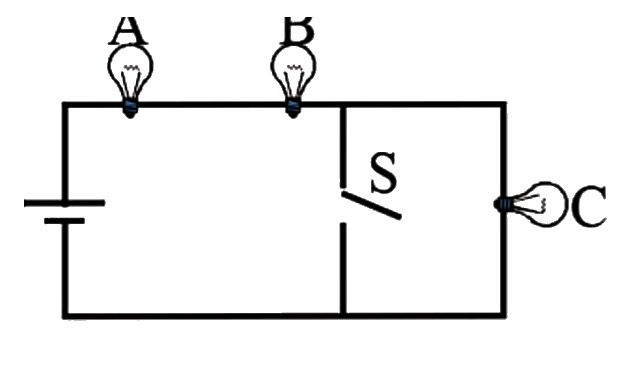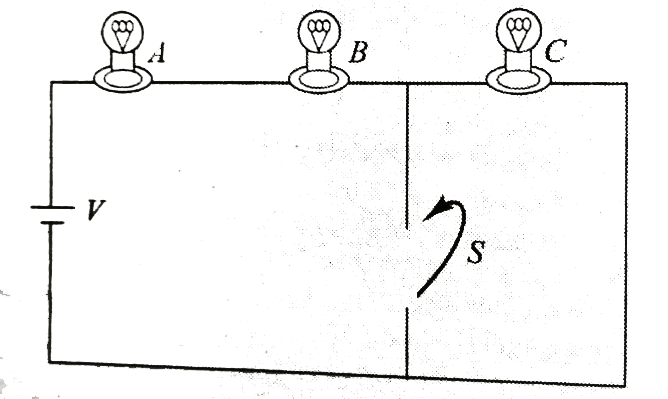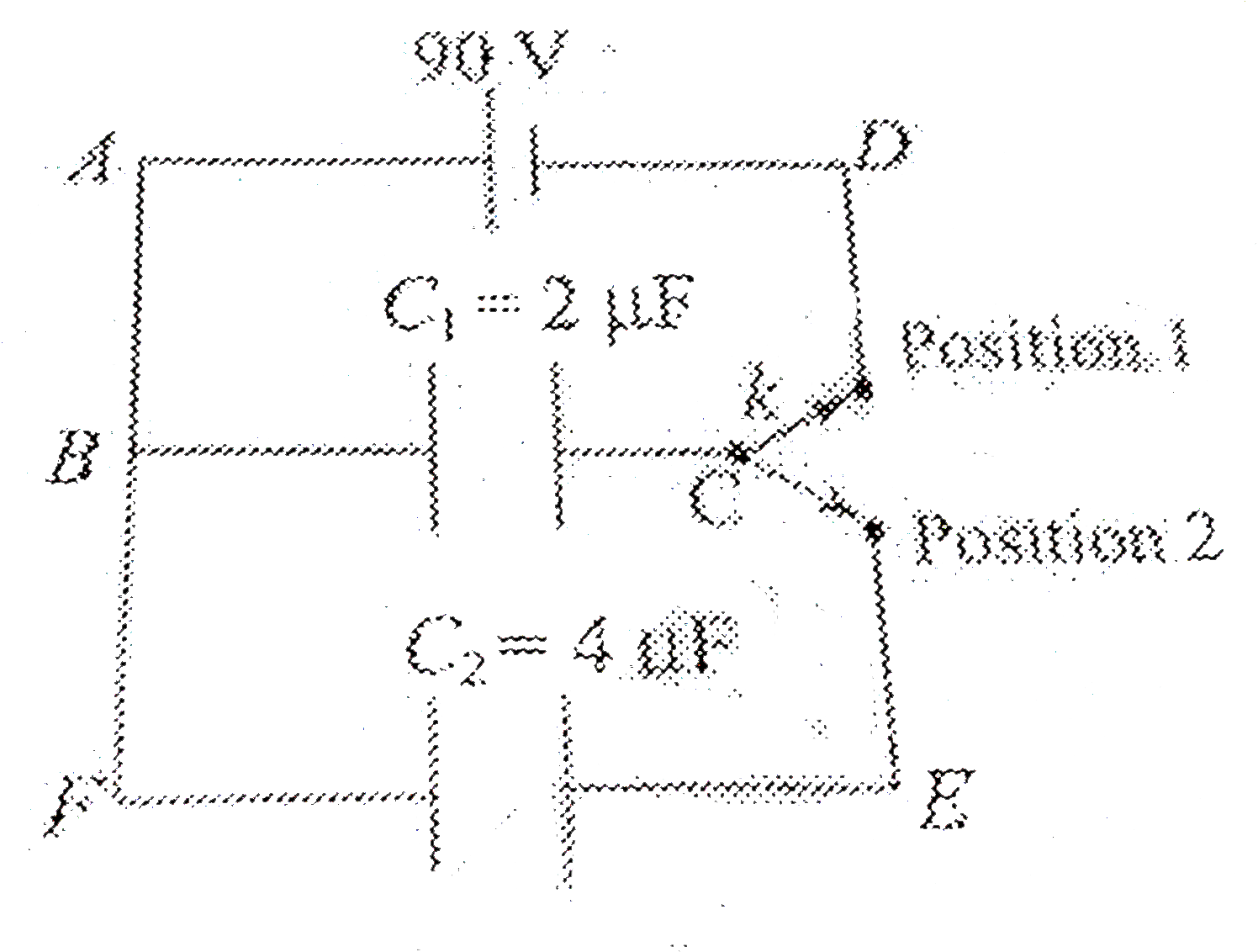A lamp in a circuit consissing of a coil of large number of turns and a battery does not light up to full brilliance instantly on switching on the circuit. Why?
Step-by-Step Solution:
1. Understanding the Circuit: The circuit consists of a lamp, a coil with a large number of turns, and a battery. When the circuit is switched on, the battery starts supplying current.
2. Current Behavior: Initially, when the circuit is closed, the current does not immediately reach its maximum value. Instead, it starts from zero and gradually increases.
3. Induced EMF: According to Faraday's law of electromagnetic induction, a change in current through the coil induces an electromotive force (EMF) in the coil itself. This induced EMF is a result of the changing magnetic field associated with the coil.
4. Opposition to Current Change: The induced EMF acts in a direction that opposes the change in current (Lenz's Law). This means that as the current tries to increase, the induced EMF will resist this increase.
5. Time to Reach Maximum Current: Due to the opposing induced EMF, the current takes time to reach its maximum value. This gradual increase in current means that the lamp does not light up to full brilliance instantly.
6. Conclusion: Therefore, the lamp does not light up instantly because the induced EMF in the coil opposes the increase in current, causing a delay in reaching the maximum current necessary for the lamp to shine brightly.
Summary:
The lamp does not light up instantly because the induced EMF in the coil opposes the increase in current, causing a delay in reaching the maximum current.
---
The lamp does not light up instantly because the induced EMF in the coil opposes the increase in current, causing a delay in reaching the maximum current.
Topper's Solved these Questions
- BOOK - AAKASH SERIESCHAPTER - ELECTROMAGNETIC INDUCTIONEXERCISE - Exercise (Very Short Answer Questions)33videos
ELECTROMAGNETIC INDUCTION
- BOOK - AAKASH SERIESCHAPTER - ELECTROMAGNETIC INDUCTIONEXERCISE - Problems (Level-I)28videos
ELECTROMAGNETIC INDUCTION
- BOOK - AAKASH SERIESCHAPTER - ELECTROMAGNETIC INDUCTIONEXERCISE - Exercise (Long Answer Questions)1videos
ELECTROMAGNETIC INDUCTION
- BOOK - AAKASH SERIESCHAPTER - ELECTRIC FIELD AND POTENTIALEXERCISE - PROBLEMS (LEVEL-II)26videos
ELECTRIC FIELD AND POTENTIAL
- BOOK - AAKASH SERIESCHAPTER - ELECTROMAGNETIC WAVESEXERCISE - EXERCISE -II22videos
ELECTROMAGNETIC WAVES
Similar Questions
A circuit consists of a coil, a switch and a battery, all in series. The internal resistance of the battery is negligible compared with that of the coil. The switch is originally open. It is thrown closed, after a time interval Δt. The current in the circuit reaches 80.0% of its final value. The switch then remains closed for a time interval much longer than Δt. The wires connected to the terminals of the battery are then short circuited with another wire and removed from the battery, so that the current is uninterrupted.
At an instant that is a time interval Δt. After the short circuit, the current is what percentage of its maximum value? a)20% b) 8% c) 4% d)10 %View SolutionA circuit consists of three identical lamps connected to a battery as shown in the figure. When the switch S is closed then the intensities of lamps A and B
 View Solution
View SolutionIn a transformer number of turns in primary circuit is 500 and in secondary circuit number of turns is 10 and load resistance to 10 Ω and voltage of secondary coil is 50 V then find the current in primary circuit .
View SolutionA uniform wound solenoidal coil of self inductance 1.8×10−4 henry and resistance 6 ohm is broken up into two identical coils. These identical coils are then connected in parallel across a 15-volt battery of negligible resistance. The time constant for the current in the circuit is.......seconds and the steady state current through the battery is ..............amperes.
View SolutionA series circuit consists of three identical lamps connected to a battery as shown in Fig. 7.13.
when the switch S is closed, what happens
(a) to the intensities of lamps AandB,
(b) to the intensity of lamp C,
( c ) to the current in the circuit , and
(d) to the voltage drop across the three lamps ?
Does the power dissipated in the circuit increase, decrease, or remain the same ?
 View Solution
View SolutionWhat is meant by electric circuit ? Why does electric current start flowing in a circuit the moment circuit is complete ? When do we say that the potential difference across a conductor in a circuit is 1 volt ?
Calculate the potential difference between the two terminals of a battery if 12 joules of work is done in transferring 2 coulombs of charge.View SolutionFigure shows two capacitors of capacitance 2μF and 4μF and a cell of 90 V. The switch 'k' is such that when it is in position 1, the circuit ABCD is closed and when it is in position 2, the circuit BCEF is closed.the resistance of both the circuits is negligible os that the capacitor gets fully charged instantly. Initially the switch is in position1. then it is turned in position 2 and then in position 1. Now two cycles are completed. Find the charge (inμC) after two cycles.
 View Solution
View SolutionTwo moving coil galvanometers 1 and 2 are with identical field magnets and suspension torque constants, but with coil of different number of turns N1 and N2, area per turn A1 and A2, and resistance R1 and R2. When they are connected in series in the same circuit, they show deflections θ1 and θ2. then θ1/θ2 is
View SolutionA 1−kΩ resistor is connected in series with a 10−mH inductor, a 30V battery and an open switch. At time t=0, the switch is suddenly closed.
a. What is the maximum current in this circuit and when does it occur?
b. What are the voltage drops across the inductor and across the resistor 20μs after the switch is closed?
c. On a single set of axes, sketch the voltage across the resistor and the voltage across the inductor as functions of time. Also, sketch a graph of the current in the circuit as s function of time.View SolutionIn a school-wide competition held at Saul C. Tigh memorial High school, Olympiad teams are challenged to come up with different circuits involving both real and imaginary currents, imaginary currents exists in spots where the electrical energy encounters zero resistance, such as through a coil or wire. Real currents exist only where the electrical energy headed through the circuit encounters resistance, such as when a light bulb "resists" the current and takes up some of the energy carried throughout the circuit.
The members of team Charlie develop a circuit in which the total current, real and imaginary, can be measured at 50+12i amps. They then add the current together with the current produced by Team Delta's circuit, 40-9i amps. Finally, they decide to multiply the resulting current, in amps, by Team Epsilon's total current, 60-2i amps. What is the final current , in amps, after the entire process is completed?View Solution

